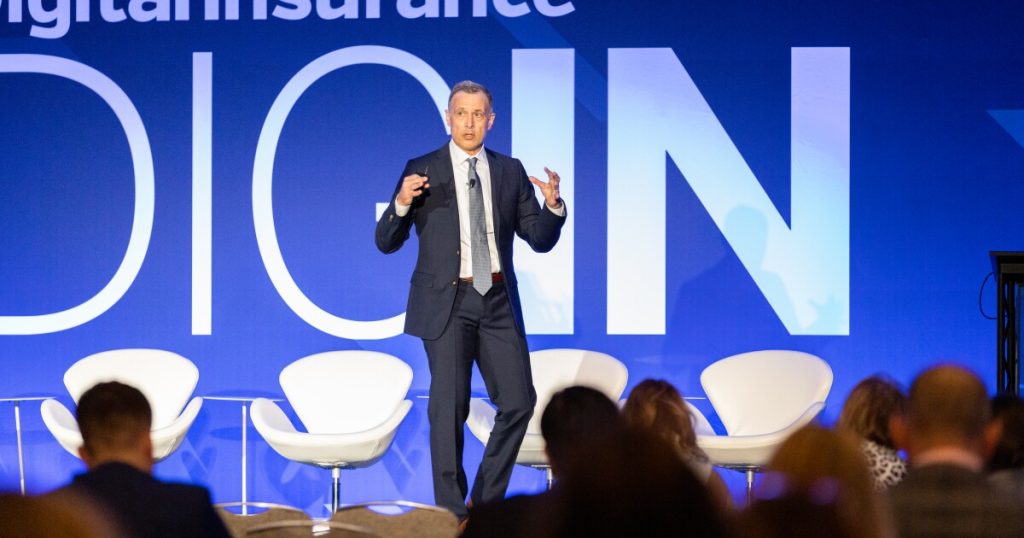Amazon's lessons for insurers on sustainable growth

Editor’s note: John Rossman was the keynote speaker at the 2021 DIGIN conference. Jocelyn interviewed him at a different time and produced the following piece. To register for this year’s conference, keynoted by Linda Bernardi, click here.
If you were to ask the average person to name some of the top, most impressive companies in the U.S., I’m sure Amazon would be one of the first mentioned. In fact, Amazon has held the No. 2 spot in Fortune’s list of the World’s Most Admired Companies for six years in a row now. Yes, that’s right, six years in a row.
It’s no wonder why, when it comes to thinking about strategy development and planning, businesses, regardless of industry, often find themselves wondering, “What would Amazon do?” Love it or hate it, there’s no denying the hold Amazon has on the attention of modern business leaders.
An insider’s view of the “Amazon Way”
But what is it about this one-time online bookseller now “American multinational technology company which focuses on e-commerce, cloud computing, digital streaming, and artificial intelligence” (as described by the company’s Wikipedia page) that piques the interest of even the most seasoned professionals? It’s something only a person who has been inside the organization, who understands the thinking behind the company’s strategic moves, and who has seen their culture in action from the beginning can truly answer.
John Rossman is a former Amazon executive who was there in the very early days of Amazon (2002-2005), helping inform and develop the future-looking marketplace strategy of the now $135.4B brand. Rossman, who now runs his own business advising firm and is a talented executive speaker, recently joined an episode of the UNBIND with Bindable podcast. Recounting his experience at Amazon, Rossman shared takeaways business leaders should consider, or implement, right away, to remain competitive in an ever-evolving digital market.
“Amazon is the most interesting company of the digital era, and that’s not because of what they do, but because of how they do it,” said Rossman. “The company has changed 10,000 times since I was there, but how they go about their work has remained very consistent.”
And that’s the very thesis of Rossman’s work, as detailed in his book now in its third edition, The Amazon Way (which, naturally, you can find on Amazon). Rossman shares the unique corporate culture and leadership principles that have continued to guide Amazon’s business decisions since the very beginning in the hopes of helping others develop strategies and think big about their place in the market.
“I’m always testing my understanding of [Amazon], seeing what’s changed, and it’s like we really worked it through in those early days of [how to] make decisions, how to think things through, how to hold each other accountable,” said Rossman.
He believes it’s that establishment of “ground rules” from the very beginning, and not straying from them, that has helped Amazon become what it is today.
“[Amazon’s] culture of accountability and great operational excellence challenge social cohesion…I think that helps make a durable team [and makes Amazon] a durable brand,” said Rossman.
Remember when Amazon was “just” a river?
Do you remember what life was like in the BA era? That is, “before Amazon?” It goes without saying that Amazon has drastically changed life as we know it, but it wasn’t always that way.
At one point, Jeff Bezos was just a simple guy, building a company out of his garage. But even then, way back in 1994, he aspired to build the company that Amazon is today. According to Rossman, Bezos always had the intention of becoming an “everything store.” Even in the early days, the team knew Amazon was a platform company and not just an online retailer.
“We understood we were a customer-obsessed company,” said Rossman.
Amazon employees, like Rossman, were organized as to be singularly focused on achieving the company’s strategic goals. Of primary importance was to understand who the company’s customers were (which in the early days, were merchants on their platform), and that they weren’t one-size-fits-all. In fact, Amazon may even have had some convincing to do when it came to acquiring customers in those early days. As Rossman puts it, “we didn’t have the leverage to force them into one way and we had to make it easy for them.”
Amazon had to find a middle ground, provide optionality for its customers, and learn from them, in order to build a bridge from what they were to where they wanted to be. Amazon had to show its merchants the value the platform could bring, educate them on what was possible, and make them think in ways they never had before. It was once Amazon could show brands the value of having an additional access point to their current – and more importantly – future customers, things changed.
“The thing people forget is…it took five or six years for the marketplace to fill in, to get sellers [in all] categories and for end-customers to understand [that they could] go to Amazon for more than just books and music, that they could go to them for all these other categories. So, the patience that it took for Amazon and for the sellers to stay at it and just let the market mature,” is what ultimately helped Amazon to succeed, according to Rossman.
“Everybody remembers the past 12 years of Amazon stock just doing nothing but going up and to the right, but we did have eight years where the stock was essentially flat, and yet Amazon operated with the exact same mindset and optimistic perspectives during that time as they have through the growth phase.”
Patience is a virtue
Rossman largely credits Amazon’s perseverance in letting the market mature as key to their success and sees that as one of the main lessons others can learn from them.
“I see too often companies do something, and they do it well, but they just get impatient. Sometimes the cure is, while it’s not good enough yet…to stay at it for a while and be patient with it.”
While everyone talks about “what’s next” in innovation, sometimes you just need more of the same. Disruption for the sake of disruption often leads to failure. But trying something new, learning something, and then calibrating, but not going in a totally different direction, is what drives innovation. As Rossman puts it, digital transformation is “a category, not a strategy.”
In a recent version of his digital newsletter, “The Digital Leader,” Rossman wrote how the vast majority of digital transformations are failing to deliver the expected business value, even though “global spending on the digital transformation of business practices, products, and organizations is forecast to reach $2.8 trillion (annually) in 2025.” Clearly, business leaders understand that digital transformation is the right path, but they lack creativity when it comes to improving the odds.
“At the end of the day, digital transformation is about creating change; it’s about testing new things. What we’re typically really good at is our operating playbook…[digital transformation] is a different playbook. [You need] agile testing, trial and error, failure from experimentation,” said Rossman.
Adding a new chapter to your playbook requires changed thinking. Slowing down and trusting your intuition helps you remain focused on what you’re trying to achieve. As Rossman says, in order to make change happen, “thinking about how you think” is the most important thing you can do.
“You do you”
As Oscar Wilde once said, “Imitation is the sincerest form of flattery.” Often overlooked, however, is the second half of that quote, which says “that mediocrity can pay to greatness.” Some may feel that if they were just even a fraction more like Amazon, they could be doing better. But that’s not necessarily true.
“It’s not about Amazon, it’s about what you can learn from a company like Amazon to put into your own culture and into your own strategies,” said Rossman. “What I’d encourage companies to do is get ahead of change. It’s so much cheaper to test and fail early, than it is to fail late…when you are failing late, that means you’re having to play catch up and either you don’t have the resources, or you have to do really expensive, high-risk things” to keep up.
By failing and testing new ideas early, you’ll have the added benefit of playing from your strengths and lessons learned. You’ll have time to let things mature, just as Amazon has proven. Rossman suggests figuring out what works for your customers; don’t build your organization into a little box based on what others are doing for their customers.
Look upstream and downstream at your customer journey – how can you reduce friction through innovation? Look at where you can grow next, even if it’s not so obvious. By trusting your understanding of what uniquely works for your business and your customers, and not just following in the steps of others, you’ll uncover new and lucrative opportunities for growth. Don’t be scared to set out alone and achieve greatness, only to end up imitating others and ending up mediocre. I think both Jeff and Oscar would agree.



